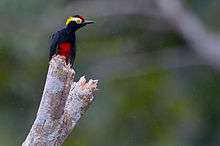Yellow-tufted woodpecker
| Yellow-tufted woodpecker | |
|---|---|
 | |
| Scientific classification | |
| Kingdom: | Animalia |
| Phylum: | Chordata |
| Class: | Aves |
| Order: | Piciformes |
| Family: | Picidae |
| Genus: | Melanerpes |
| Species: | M. cruentatus |
| Binomial name | |
| Melanerpes cruentatus (Boddaert, 1783) | |
The yellow-tufted woodpecker (Melanerpes cruentatus) is a species of woodpecker. It is found in Bolivia, Brazil, Colombia, Ecuador, French Guiana, Guyana, Peru, Suriname, and Venezuela. Its natural habitats are subtropical or tropical moist lowland forests and heavily degraded former forest.[1]
Description
An adult is about 20 cm (8 in) long. The upper parts are mostly bluish-black, as are the cheeks, chin, throat and chest. The breast and belly are red, although the amount of red is variable, and the flanks and lower belly have black and white undulating barring. The rump and upper tail-coverts are white, this being noticeable in flight, and the tail is black. The underside of the wing is barred in black and white. The beak is blackish, the legs grey, and the iris and orbital ring are yellow. The male differs from the female in having a red fore- and mid-crown while the female has these parts black. In northern and western races, the brow is yellow, cream or buff, and the hind-crown ha yellow or golden feathers, these often being tufted, but in southern races, these areas are black. Juveniles are similar to the adults but the upper parts are browner and the underparts are greyer; juveniles of both sexes have some red on the crown and the belly is more orange than red.[2]
Distribution and habitat
The yellow-tufted woodpecker is native to northern South America. Its range includes eastern Colombia, western and southern Venezuela, the Guianas, northern and central Brazil, eastern Ecuador, eastern Peru and eastern Bolivia. Its altitudinal range is from sea level to about 1,200 m (3,900 ft), and even higher in Ecuador. It is a species of open humid forest, both varzea and terra firme forest, and is also found in secondary forest, woodland verges and burnt out areas with isolated standing trees. It is a non-migratory species.[2]
Ecology
The species is social and gregarious and often forages in groups. Its diet is omnivorous, consisting principally of insects, some of which are caught on the wing, and fruits.[2]
Status
With the destruction of the Amazon rainforest, the habitat of this woodpecker is being degraded and the population is thought to be in gradual decline. However, it is a common bird with a very wide range, and the International Union for Conservation of Nature has assessed its conservation status as being of "least concern".[1]
References
- 1 2 3 BirdLife International (2016). "Melanerpes cruentatus". IUCN Red List of Threatened Species. Version 2016.3. International Union for Conservation of Nature. Retrieved 6 May 2017.
- 1 2 3 Gorman, Gerard (2014). Woodpeckers of the World: A Photographic Guide. Firefly Books. pp. 115–116. ISBN 177085309X.
